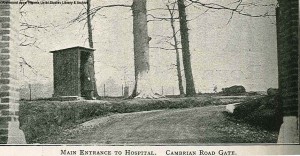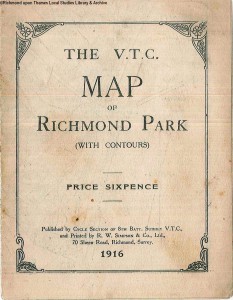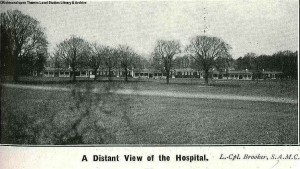Follow the Drum: The South African Presence
Patricia Moloney, Heritage Assistant, takes a look at the impact of the increasingly international military presence in Richmond during the Great War. The town was assuming a cosmopolitan character as numerous troops from all parts were stationed here. The population was changing; for example, the Belgian Refugees had already become a significant body of civilians, influencing daily life in the borough and nation.
Background
Although Richmond was never designated as a Garrison town throughout the First World War there was always a large military presence in the town. This could comprise troops being moved from and to the front through the town or for example the Third Battalion Signallers, (London Scottish Regiment) encamped in Richmond Park from May 1915. This situation was happening all over the country as ‘new armies’ were taking up residence in camps under canvas or in huts.
 The South Africans arrive
The South Africans arrive
One hundred years ago the South African Military Hospital in Richmond Park opened in 1916 near Richmond Gate as the South African Hospital. The hospital actually stood near the Cambrian Road pedestrian entrance. The V.T.C Map of Richmond Park 1916 (then priced sixpence) features the hospital.  The map was drawn up by the cycle section of the 8th Batt. Surrey Volunteer Training Corps (cf image). It is worth noting that this map also featured the Army Camp of 1915 and that the development of the map is referenced in an article written for the March 1916 Surrey Volunteer Review, (pp 76 – 8, L 940.4I R).
The map was drawn up by the cycle section of the 8th Batt. Surrey Volunteer Training Corps (cf image). It is worth noting that this map also featured the Army Camp of 1915 and that the development of the map is referenced in an article written for the March 1916 Surrey Volunteer Review, (pp 76 – 8, L 940.4I R).
Origins & Development
By 1917 the hospital housed approximately 700 South African soldiers. It later merged in July 1918 with the Richmond Military Hospital to form the South African Military Hospital. It was paid for by the South African Hospital and Comforts Fund Committee, whose members were mostly wealthy South Africans living in the UK. The committee was chaired by Lord Gladstone who had been until recently Governor General.
Royal consent to build in the park was given by King George V. The Park section stood on 12 acres in an enclosed site. The building itself was constructed of timber with felt and weather-board linings on the outside and asbestos board-sheeting on the interior walls and ceilings of all wards and principal rooms. Patients suffering from severe wounds were treated in the six fire-clay continuous baths. The bath ward was a special feature of the South African Military Hospital.
There was careful planning between the architect Mr Allison and Lieutenant-Colonel Stock. At that point financial reasons prevented providing 500 beds so a decision was made to start with 300. This was written into plans in detail which provided for future extensions. According to Buchan in The History of the South African Forces in France (Thomas Nelson & Sons, 1925) the personnel for the Depot in England and the South African Military Hospital at Richmond was provided by No. 2 General Hospital, Maitland. This included representatives from each of the four provinces of the Union.
Although no hospital equipment was available in South Africa, the official Advisory Committee on Voluntary Aid, chaired by Sir Thomas Smartt met the difficulty by voting £15,000 to purchase it on arrival in England. A further £1,500 was allocated to augment the equipment taken by the Field Ambulance. Two units accompanied the South African Infantry Brigade, the General Hospital embarking on H.M.T Balmoral Castle at Cape Town on 25 September 1915. The Field Ambulance on H.M.T Kenilworth Castle arrived on 10th October 1915. (Buchan). Subsequent to their arrival in England they proceeded to the R.A.M.C. Depot at Twezeldown, near Aldershot where the Field Ambulance trained under its own officers. It was present when the Queen reviewed the troops on 2nd December 1915 at Bordon. The medical staff consisted of 13 officers of the South African Medical Corps, and 11 civilian practitioners.
The actual construction of the hospital started in early March 1916 and was completed by June. It was formally opened by its patroness, H.R.H Princess Christian on 16 June 1916, being then taken over as a gift, fully equipped, from the South Africans by the D.D.M.S., London District, on behalf of the Army Council. (Buchan).
Funding
An appeal for funds in September 1916 was followed by a generous donation by Mr Otto Beit which enabled the work on an extension to go forward. Part of this appeal by the Committee was to offer the privilege of naming a bed in the hospital to any persons or institution making a gift of £25, and of naming a ward for a donation of £600. This appeal resulted in 99 beds and 8 wards thus being named. Approximately 265 of the beds being donated were gifts of schools in South Africa. A Mr Maskew Miller of Cape Town coordinated this aspect of the appeal.
Opened for patients in February 1917, the demand for beds was ever increasing so further conversion of the orderlies’ quarters and renting a neighbouring house as an annex enabled the provision of 620 beds for patients by April 1917. The Richmond Hospitals amalgamated with the South African due to a proposal made by the War Office in April 1918. Although the enlarged hospital provided 1,098 beds a further 250 emergency beds were added by billeting the patients. (Buchan). Due to four auxiliary hospitals being attached, the total number of beds then came to 1,321 (including billets it was 1,571).
 Best Practice
Best Practice
During the war years the South African Military Hospital in Richmond Park was always considered to be an example for other hospitals to model. Sadly, it closed as a hospital in 1921 and was demolished in 1925.
Visit the Richmond upon Thames Local Studies Library & Archive to find out more about the South Africans in Richmond at this time in our local history from a fascinating range of archive material. Full details about our location and opening times are available if you click here.
Future blogs will look at the role the South Africans played locally and in the War.
[ Patricia Moloney, Heritage Assistant ]

